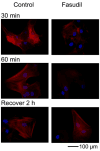Rho Kinase Inhibitors as a Novel Treatment for Glaucoma and Ocular Hypertension
- PMID: 30007591
- PMCID: PMC6188806
- DOI: 10.1016/j.ophtha.2018.04.040
Rho Kinase Inhibitors as a Novel Treatment for Glaucoma and Ocular Hypertension
Abstract
In an elegant example of bench-to-bedside research, a hypothesis that cells in the outflow pathway actively regulate conventional outflow resistance was proposed in the 1990s and systematically pursued, exposing novel cellular and molecular mechanisms of intraocular pressure (IOP) regulation. The critical discovery that pharmacologic manipulation of the cytoskeleton of outflow pathway cells decreased outflow resistance placed a spotlight on the Rho kinase pathway that was known to regulate the cytoskeleton. Ultimately, a search for Rho kinase inhibitors led to the discovery of several molecules of therapeutic interest, leaving us today with 2 new ocular hypotensive agents approved for clinical use: ripasudil in Japan and netarsudil in the United States. These represent members of the first new class of clinically useful ocular hypotensive agents since the US Food and Drug Administration approval of latanoprost in 1996. The development of Rho kinase inhibitors as a class of medications to lower IOP in patients with glaucoma and ocular hypertension represents a triumph in translational research. Rho kinase inhibitors are effective alone or when combined with other known ocular hypotensive medications. They also offer the possibility of neuroprotective activity, a favorable impact on ocular blood flow, and even an antifibrotic effect that may prove useful in conventional glaucoma surgery. Local adverse effects, however, including conjunctival hyperemia, subconjunctival hemorrhages, and cornea verticillata, are common. Development of Rho kinase inhibitors targeted to the cells of the outflow pathway and the retina may allow these agents to have even greater clinical impact. The objectives of this review are to describe the basic science underlying the development of Rho kinase inhibitors as a therapy to lower IOP and to summarize the results of the clinical studies reported to date. The neuroprotective and vasoactive properties of Rho kinase inhibitors, as well as the antifibrotic properties, of these agents are reviewed in the context of their possible role in the medical and surgical treatment of glaucoma.
Copyright © 2018 American Academy of Ophthalmology. Published by Elsevier Inc. All rights reserved.
Conflict of interest statement
MJ: none
Figures




References
-
- Johnson M, Erickson K. Mechanisms and routes of aqueous humor drainage. In: Albert DM, Jakobiec FA, editors. Principles and Practice of Ophthalmology. Vol. 4. Philadelphia: WB Saunders Co; Glaucoma; 2000. chapter 193B.
-
- Grant WM. Clinical measurements of aqueous outflow. Archives of Ophthalmology. 1951;46:113–31. - PubMed
-
- Grewe R. Zur Geschichte des Glaukoms. Klin Mbl Augenheik. 1986;188(2):167–9. - PubMed
Publication types
MeSH terms
Substances
Grants and funding
LinkOut - more resources
Full Text Sources
Other Literature Sources
Molecular Biology Databases

